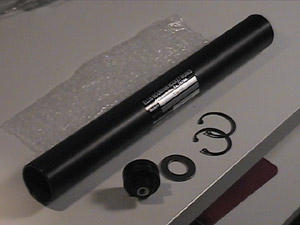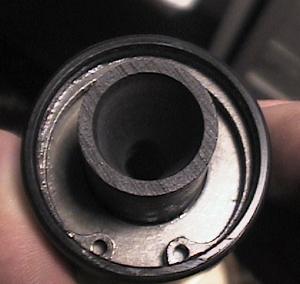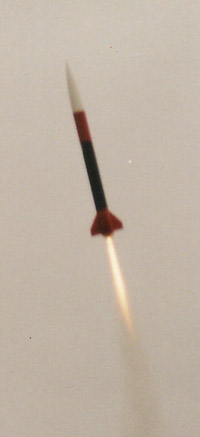Ellis Mountain Rocket Works Ellis 38-650 (I230)
Ellis Mountain Rocket Works - Ellis 38-650 (I230) {Motor}
Contributed by Theo McDonald
| Construction Rating: | starstarstarstarstar |
| Flight Rating: | starstarstarstar_borderstar_border |
| Overall Rating: | starstarstarstarstar_border |
| Manufacturer: | Ellis Mountain Rocket Works |
Brief:
The Ellis I230 is a 38mm load for the Ellis 38-650 case. The case utilizes snap ring type closures, and is made of the thicker (0.095") wall aluminum tubing. All the cases that I have seen are anodized black. The I230 and all currently available Ellis motors use the Thors Hammer propellant, a mid to slow burning propellant. More on this later.
As most snap Ring type motors use a reusable nozzle, Ellis motors have one-time use nozzles. However depending on which load you have, and the date of manufacturer, the nozzle material will differ. I have seen both a graphite nozzle and an Aerotech type nozzle. Both nozzles are bonded to a Phenolic liner. The Graphite nozzles had a much larger expansion cone, however I am unaware of the difference in motor performance between these nozzles.
 Construction:
Construction:
The motor is a 6-grain motor. The motor has no liner; the grains are placed directly into the case. It is crucial that the grains be heavily greased, or motor cleanup will be nearly impossible. The Forward bulkhead is a solid metal closure, with a flat surface facing inward. It has a threaded forward section for 'C' bolts, eyebolts or any other threaded metal. A spacer is placed in front of this closer and then the grains are added. A single O-ring seals the forward bulkhead by a single groove similar to the nozzle. An inhibitor disk is placed after the last grain, then the nozzle is installed with another O-ring as a seal. A washer is then placed over the nozzle where the expansion cone fits cleanly though the center of the washer. The last snap ring is then put into place.
The cases do not have a thrust ring, so one can either be made from tape or some other system. For me personally, I cleaned the external surface of the case with alcohol, wiped dry and placed enough wraps of masking tape at the aft to be nearly the thickness of a PML 38mm Phenolic tube.
I then clamp a hose clamp onto this masking tape and the small exposed part of the motor mount. It has worked for me, and there are many ways to safely hold the motor in the motor mount.
Construction Rating: 5 out of 5
 Flight:
Flight:
Flying the motor: I have flown this motor on a roughly 8 pound 4" diameter Patriot. I would recommend a relatively light rocket even though the motor is classified as 96% I, and a max thrust of 364 Newton Seconds. I have flown this Rocket in the motor to ~2777+ feet. I use a R-DAS with RRC as backup since the I-230 is a plugged motor.
Some people have had trouble with ignition, however the motor seems to light just as easy as any Aerotech standard White lightning motor. Some issues to keep in mind, when installing the forward closure and nozzle, make sure the O-rings are not cut from the passing by over the snap ring groove. Also make sure the nozzle fits before going to the field. Some have been known to need sanding to fit, however as you will see the sanding is worth the effort. All parts should be greased well for much easier loading. I have found that the motor burns just a little longer than the predicted 2.8 seconds, however the thrust is still as high as advertised. For cleanup, I would highly recommend buying a dowel that fits well in the motor to push out the paper, which the grains were cast in. I use a plastic broken ski gate with two wraps of duct tape. This makes motor clean up much faster since with out this type of ram, removing the liners would be nearly impossible. It is also key that the motor be cleaned well, I have simply used #8 rubber stoppers to put on each end and partially filled with vinegar and then shaken. I also soak all parts in vinegar the night after firing the motor.
Flight Rating: 3 out of 5
Summary:
Pro's:
- Excellent motor for a lighter rocket.
- Good strong case.
Cons:
- Nozzle may need sanding.
- Not a very reliable performance
- The thrust curve varies from motor to motor.
Overall Rating: 4 out of 5
 |
 |